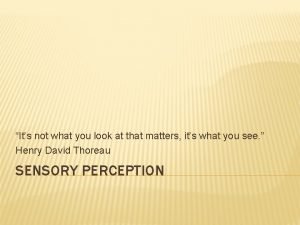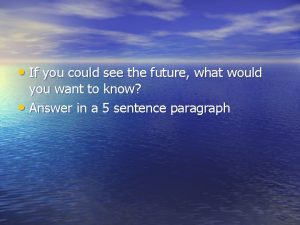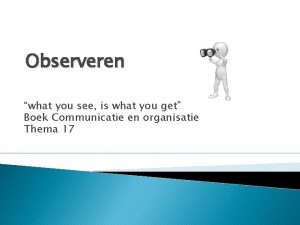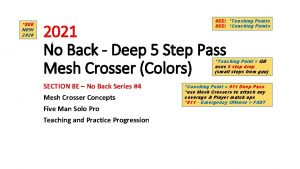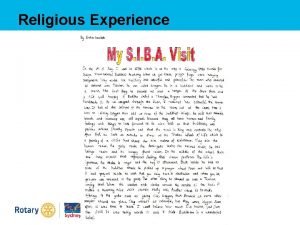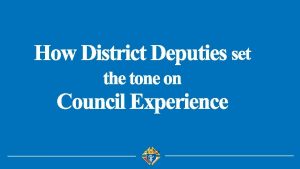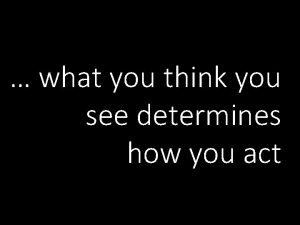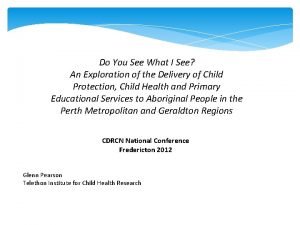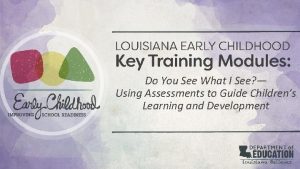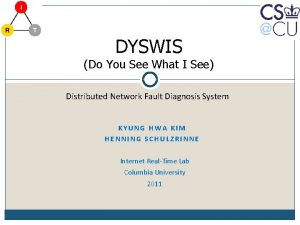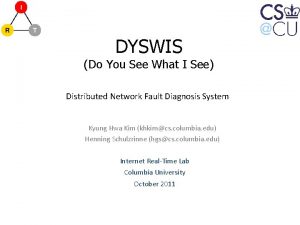Do you see what I see Experience the


























- Slides: 26

Do you see what I see? Experience the development of a supportive risk-taking environment that invites deep learning Shelley Schuurman Ph. D, LMSW Grand Valley State University GVSU Fall Conference on Teaching & Learning August 22, 2012

HIGH IMPACT PRACTICES STUDENT ENGAGEMENT = DEEPLEARNING Faculty are being challenged to: � Equip students with the personal capacities and skills needed to succeed in our fast-paced global economy � Educational research says: High impact educational practices promote student engagement resulting in deep learning and increase the likelihood of students mastering the personal capacities and skills employers deem essential for success in today’s workforce(Kuh, 2009)

Why are high impact practices effective at promoting deep learning ? Students experience: Increased time and effort in purposeful activities Circumstances that DEMAND interaction with faculty and peers about important issues for extended periods of time Diverse experiences that promote new ways of thinking and responding to new information Frequent and at times immediate feedback about their performance Ability to apply knowledge in real world settings Deeper understanding of their values & beliefs and an increase self- understanding in relation to others and the larger world

DEEPLEARNING is all about making CONNECTIONS 21 st century learners are wired to connect to multiple sources of information simultaneously and rapidly moving from one thing to the next… What happens when they unplug? Are they connected to themselves? Are they really connected to others? Are they equipped to connect face-to-face with faculty & their peers?

Do you see whatwh what I see?

How has the (almost constant) use of technology impacted 21 st century learners?

A look at the impact of the networked lives of students � They would rather text than talk � They welcome interruptions (texts, calls) � They’ve become experts at multi tasking � Connected all day but not sure if they have really communicated � On-line connections have become a substitute for face to face interaction � Allows them to hide form each other though they are tethered to each other (Turkle, 2011)

A look at the impact of the networked lives of students Decreased impulse control Increased need for instant gratification Increased anxiety Decreased time to sit and think uninterrupted Less willing to get out there and take a chance Afraid of spontaneity and authenticity Long for undivided attention (Turkle, 2011)

DEEP LEARNING requires students to CONNECT in ways that have become unfamiliar to them They have to UNPLUG and CONNECT with THEMSELVES Reconnect with SELF REFLECTION Practice being STILL

DEEP LEARNING requires students to CONNECT in ways that have become unfamiliar to them. They have to: Connect with Others Face to Face Get Comfortable being Fully Present Take Risks & Dare to be Vulnerable Practice Authenticity Embrace Imperfection

The question, then is: How do we help students become more comfortable with connection? In another life, I was an Adventure-based Challenge Course Facilitator; so when I started to have groups of students who just didn’t engage with the material… I intuitively began infusing the Adventure- based learning philosophy into my teaching I adapted some of the ice breaker and small group cooperative activities to fit the course content At the same time I also discovered Barley’s book and found that her model for student engagement mirrors the adventure- based learning philosophy End Result= Students actively engaged!

Adventure- based Learning Philosophy Individuals are usually more capable (mentally, emotionally and physically) than they perceive themselves to be, and if given the opportunity to TRY in a supportive atmosphere, can discover this excellence within themselves.

Four primary concepts: The Edge The Trust Platform The importance of Sequencing activities The Role of the Facilitator

The Edge Comfort Zone Risk or Growth Zone Panic Zone

Trust Platform (and or) Full Value Contract � Effort= hold self and others accountable to 100% effort toward the goals � Emotional Safety= hold self and others accountable for maintaining an emotionally safe environment � Feedback= Commit to giving and receiving feedback in the above mentioned areas

Sequencing Activities THIS IS KEY! Icebreakers: Goals of the activity: Have fun, give permission to be silly Begin group interaction in a non-threatening manner Cooperative Activities: Goals of the activity: Learn about each other in a more personal way Develop a cooperative and supportive atmosphere

Role of the Facilitator � Set the stage and develop trust � Maintain group safety � Intentionally plan for spontaneity and unpredictability � Let the group do the work � Convey that the participants have the resources needed to be successful � Coach

Barkley’s Model of Student Engagement Student engagement which occurs when motivation and active learning work together synergistically MOTIVATION It’s an internal state It’s reactive to pressures from � extrinsic rewards or � internal needs (Barkley, 2010)

How do we motivate students? � Establish supportive relationships � Cooperative/collaborative learning � Minimize the pressure that makes performance or work avoidance more likely so students can focus on learning without becoming distracted by fear of embarrassment or failure (Barkley, 2010)

Active Learning The mind is actively engaged What does this look like: Students are dynamic participants in their learning Students reflect on and monitor both the process and the result of their learning Students make information their own by connecting it to their existing knowledge and experience (Barkley, 2010)

Three Classroom Conditions that promote this synergy Creating a Sense of Community � Create a safe space for learning to occur � Explain to students how learning occurs and the need for them to enter the “Risk Zone” � Be very mindful of the role of “sequencing” � Develop collaborative or cooperative learning activities(Barkley, 2010)

Three Classroom Conditions that promote this synergy Helping students work at their Optimal Level Intentionally plan for unpredictability in safe learning environment Develop learning activities that are rooted in the every day context of student life Frequent Assessment and Feedback Teach Metacognitive Skills Empower Students as Partners in the Learning Process (Barkley, 2010)

Three Classroom Conditions that promote this synergy Teaching so that students Learn Holistically � Recognizing the important role of Affective Learning � Integrating Cognitive, Affective, and Psychomotor Domains Get them up and moving! (Barkley, 2010)


References Barkley, E. (2010). Student Engagement Techniques: A Handbook for College Faculty. San Francisco: Jossey- Bass. Fink, L. D. (2003). Creating Significant Learning Experiences: An Integrated Approach to Designing College Courses. San Francisco: Jossey Bass. Kuh, G. (2008). High-Impact Educational Practices. Washington DC: Association of American Colleges and Universities.

References Rohnke, K. and Bulter, S. (1995). Quick Silver: Adventure Games, Initiative Problems, Trust Activities and a Guide to Effective Leadership. Hamilton, MA: Project Adventure, Inc. Turkle, S. (2011). Alone Together: Why We Expect More from Technology and Less from Each Other. New York: Basic Books.
 Imprint definition psychology
Imprint definition psychology Early experience vs. later experience
Early experience vs. later experience Example of indirect experience
Example of indirect experience It's not what you look at that matters, it's what you see.
It's not what you look at that matters, it's what you see. Major prophets
Major prophets Good morning nice to see you
Good morning nice to see you Buenas tardes
Buenas tardes Observatiedoelen
Observatiedoelen Hình ảnh bộ gõ cơ thể búng tay
Hình ảnh bộ gõ cơ thể búng tay Lp html
Lp html Bổ thể
Bổ thể Tỉ lệ cơ thể trẻ em
Tỉ lệ cơ thể trẻ em Chó sói
Chó sói Glasgow thang điểm
Glasgow thang điểm Hát lên người ơi
Hát lên người ơi Các môn thể thao bắt đầu bằng tiếng bóng
Các môn thể thao bắt đầu bằng tiếng bóng Thế nào là hệ số cao nhất
Thế nào là hệ số cao nhất Các châu lục và đại dương trên thế giới
Các châu lục và đại dương trên thế giới Công thức tiính động năng
Công thức tiính động năng Trời xanh đây là của chúng ta thể thơ
Trời xanh đây là của chúng ta thể thơ Cách giải mật thư tọa độ
Cách giải mật thư tọa độ Làm thế nào để 102-1=99
Làm thế nào để 102-1=99 Phản ứng thế ankan
Phản ứng thế ankan Các châu lục và đại dương trên thế giới
Các châu lục và đại dương trên thế giới Thơ thất ngôn tứ tuyệt đường luật
Thơ thất ngôn tứ tuyệt đường luật Quá trình desamine hóa có thể tạo ra
Quá trình desamine hóa có thể tạo ra Một số thể thơ truyền thống
Một số thể thơ truyền thống



